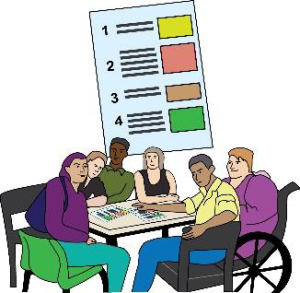
Independent living means Disabled people living in the community with the same choices, control and freedom as any other citizen, including having choice and control over things like who they live with and where.
This requires the removal of barriers to equality of opportunity, and for any practical assistance to be based on Disabled residents' choices and aspirations.
Independent living is an important part of the UN Convention on the Rights of Person with Disabilities (UNCRPD) (Article 19).
It is not just about 'social care' and it does not mean Disabled People doing everything for themselves. The same principles extend to people of all ages who have long-term health conditions including children, young people and older people.
We use the words Disabled people to talk about all Disabled people. This means people with different barriers.
Physical barriers - this affects the way a person can move or get around.
Cognitive barriers - this affects the way a person can communicate, make decisions, and remember things.
Sensory barriers - this affects the way a person touches, smells, sees or hears.
And residents who use services who face barriers for a range of reasons and require support.
The 'Nothing About Disabled People Without Disabled People' report was produced by our Disabled People's Commission and agreed by the council Cabinet.
The commission recommended that an independent living strategy be developed in co-production with Disabled residents of all ages in Hammersmith & Fulham.
Over the last few decades, we have seen major improvements in Disabled people's life chances.
Our society now expects Disabled people to be treated with respect, to have opportunities, to live in their own homes with their own families and make their own contributions to their local communities and to society generally, but we have much more to do.
The H&F vision for Independent living takes a social model of disability approach.
The social model of disability was developed by Disabled people. It says that Disabled people, people with impairments and health conditions, are 'Disabled' by the barriers in society.
These barriers discriminate against Disabled people and push Disabled people out of society. It is the way society is run and organised that is the problem, not the Disabled person. Discrimination and exclusion are things that can be stopped. Using the social model helps us to recognise the barriers and make the changes needed.
We also recognise that Disabled people may face discrimination for more than one reason. For example, a Black Disabled person may face discrimination because they are a Disabled person and because of the colour of their skin. That's why independent living is also a central part of our approach to equality, diversity and inclusion.
Leadership and representation by Disabled people is vital to achieving change and equality. However, it is still common for non-Disabled people to run organisations and speak for Disabled people.
That is why we are working with local Disabled people's organisations (DPOs) and investing in building the skills and capacity of Disabled residents to co-produce and lead the changes.
The independent living strategy will enable a change of culture by embedding the 12 Pillars to Independent Living as defined by Disabled people 50 years ago, but which are still as relevant today.
These will be our framework for change as these are what impact on people's lives and inclusion.
The 12 pillars are:
- Full access to our environment
- A fully accessible transport system
- Appropriate technical aids and equipment
- Accessible and adapted housing
- Personal assistance to enable an independent lifestyle.
- Inclusive education and training
- An adequate income
- Equal opportunities for employment
- Appropriate and accessible information
- Advocacy (towards self- advocacy)
- Empowering counselling services
- Appropriate and accessible healthcare provision
We also need to address other things that are important to people's full inclusion, connections and sense of identity such as:
- access to community
- recreation
- leisure
- digital inclusion.
Part of the culture change is about language.
The language traditionally used in social care, for example, has been unhelpful in terms of facilitating independent living. So a new more empowering language should be adopted which encourages real choice and control in Disabled people's lives.
The following table offers some alternatives.
| Social care | Independent living |
|---|---|
| Being looked after | Choice |
| Cared for | Control |
| Getting up | Autonomy |
| Being fed | Self-determination |
| Put to bed | Freedom |
| Medication time | Human Rights |
| Task oriented | Participation |
| Doing to | Citizenship |
| The '15 minutes call' | Spontaneity |
| Care agency | A family life |
| Living at home as it's cheaper | A lifestyle - choosing how to live |
| Being washed | Equality |
| Fitting into available services (time oriented) | Flexibility |
| Care plan | Creativity to resolve |
| Health and safety procedure | Taking risks |
Our borough-wide commitment to independent living will be further developed with residents, community organisations and business partners.
Together we will address the discrimination that Disabled people and their families and supporters experience in their everyday lives and pave the way, in a challenging financial climate, by creating better support and services with residents making independent living a reality.
Published September 2022